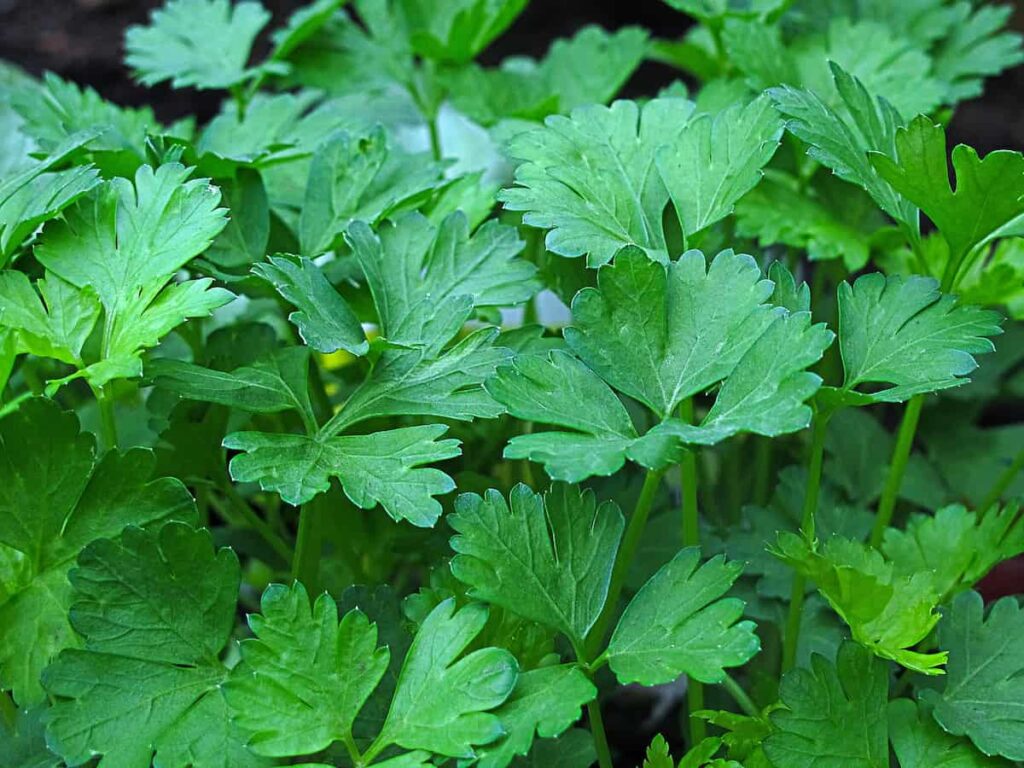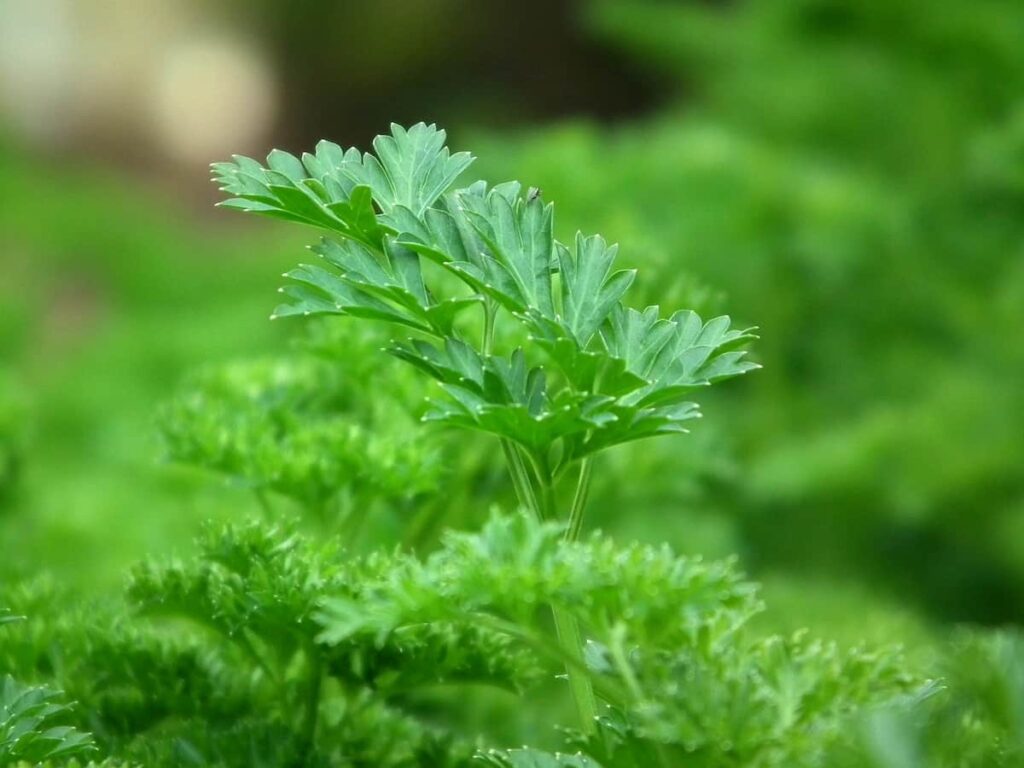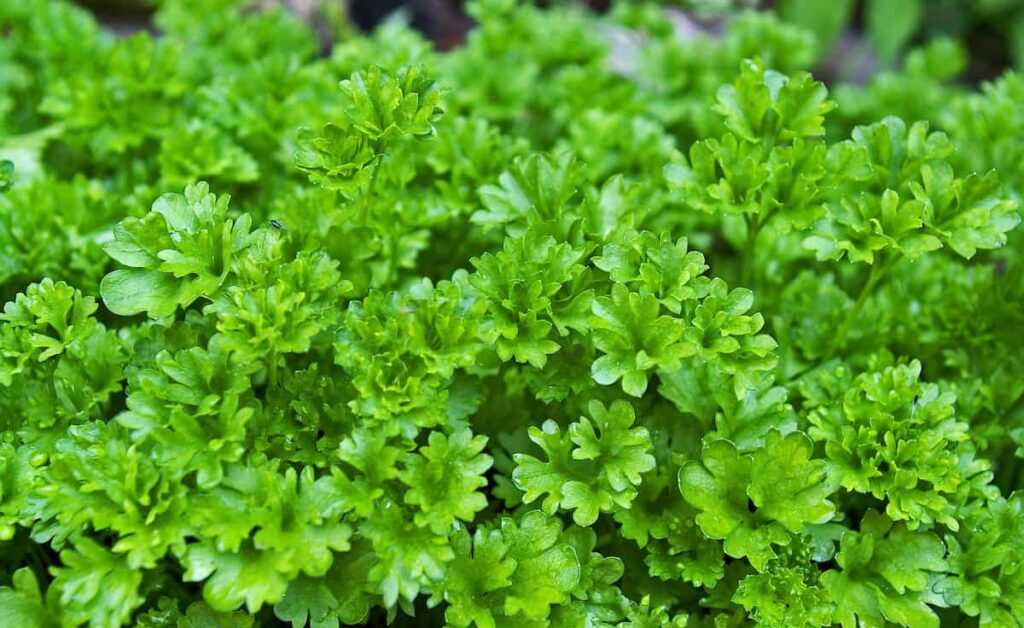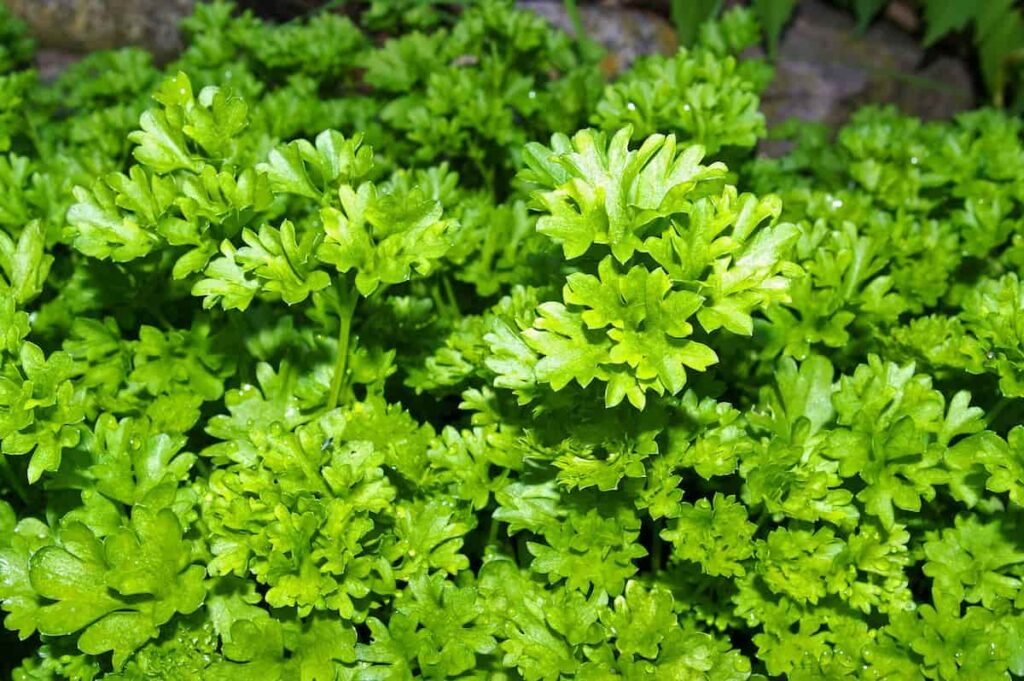Parsley is a delicious, nutritious herb that can be used in many dishes. Growing Parsley from seed to harvest is easy, and it’s a great plant in any kitchen garden. With patience and the right conditions, anyone can successfully grow Parsley indoors. You should start with fresh seed. If you have an old seed, it may not germinate. Parsley requires light to germinate, so don’t plant it too deeply. Growing Parsley from seed is the best way to add this versatile herb to your cooking.

How to grow Parsley from seed
How much time does it take for Parsley to grow fully?
- Parsley seeds typically take between 14 to 28 days to germinate. However, the germination rate is variable. Once the seedlings have sprouted, you’ll be able to start harvesting in about six weeks if the plants are exposed to their preferred conditions.
- Parsley is a fast-growing herb that can be ready to harvest in as little as eight weeks from seed. Of course, the size of your Parsley plants will affect how long it takes to reach maturity. Larger plants will take longer to produce mature leaves than smaller ones.
Tips to know about harvesting Parsley
- When harvesting Parsley, select stems with three or more branches. Cut stems with just one or two branches and leave the rest alone. Most Parsley plants should be ready to harvest within 60 to 70 days of you planting them.
- To harvest Parsley, you must cut it at the stem. You can cut Parsley at any height, but it is typically harvested when it is about 6-8 inches tall. When cutting Parsley, use sharp shears or a knife not to damage the plant.
- Leave the inner parts of the plant to grow more before you harvest them again. Ideally, allow at least two weeks between major harvests.
- Parsley is ready to harvest when the leaves are bright green and tender. Cut the stems above the soil line with scissors or gardening shears. You can cut Parsley back several times during the growing season.
Should you let Parsley flower?
- Pinch back any Parsley that has flowers. Check on your Parsley plants to see if they have any blooms. If the blooms are beginning to turn brown, it’s important that you pinch them back (deadhead) before the plant produces seeds.
- In its second year of growth, Parsley will flower and produce seeds. Cut off the flower stalks before they go to seed if you want to extend the life of your plant. Once the plant has flowered and gone to seed, it will die back. Cut it down to the ground and add some organic compost or manure to the soil around it. With a little love and care, your Parsley plant will sprout anew and provide you with fresh leaves for years to come.
- If you’re growing Parsley for its foliage, you’ll want to cut the flower stalks as they appear. Left to mature, Parsley flowers go to seed, and the plant’s energy goes into producing seeds rather than leaves. The result is a bitter-tasting herb with fewer nutrients. If you’re growing Parsley for its seeds, on the other hand, let the plants flower and go to seed.
In case you missed it: Growing Parsley from Cuttings, Seeds, Planting, Care

Germinating Parsley seeds in a paper towel
One of the easiest ways to germinate Parsley seeds is using a paper towel. Moisten a paper towel with water and then place the seeds on top. Fold the paper towel over the seeds, ensuring they are covered, and then place them in a warm location. Check on the seeds daily, and plant them in the soil once they have sprouted.
Growing Parsley in pots
- You can grow Parsley in any size or shaped pot, and it’s just as easy to grow in a small pot as in a large one. Because they have roots that are so deep, they need something bigger than 12 inches deep.
- Parsley is a versatile and easy-to-grow herb that does well in pots. Growing Parsley in pots is great for this popular herb for cooking and garnishing. Plus, it’s a pretty plant that adds interest to your indoor or outdoor space.
- Before the last frost date, sow Parsley seeds indoors for 6 to 8 weeks or direct sow outdoors after the last frost date. Keep the soil moist and fertilize every 2-3 weeks with a half-strength fertilizer solution. When Parsley plants are 4 to 6 inches tall, thin them. Parsley is ready to harvest when leaves are full and green (usually 60-70 days after planting). Cut leaves as needed, and leave some on the plant so it can continue growing.
In case you missed it: How to Grow Marjoram from Seed: A Detailed Guide for Planting to Harvest

The life cycle of Parsley
Parsley is a biennial plant; it takes two years to complete its life cycle. The herb grows edible leaves the first year, then goes to seed the second year, and dies. North-grown Parsley can tolerate some frost but is killed by freezing temperatures.
Water requirement for growing Parsley
- Parsley seeds will not germinate all at once. To encourage more germination, keep the soil moist but not wet. Once they reach full size, plants need 1 to 2 inches of rain or supplemental watering per week.
- Water is the key element in keeping Parsley healthy. You’ll have to water your Parsley regularly, at least once or twice weekly. Allow the soil to dry mostly before you water again.
- Parsley is a relatively drought-tolerant herb that needs a consistent water supply to produce plenty of foliage. Water Parsley plants deeply and less frequently rather than shallowly and more often. This encourages roots to grow deep into the soil, making the plant more drought-tolerant. When watering, focus on the root zone rather than wetting the leaves, which can promote fungal diseases.
- Parsley is a fast-growing herb that can be grown from seed. It prefers full sun and well-drained soil. Water Parsley seeds generously, about 1 inch per week, until they germinate. Once the seedlings are established, water them deeply about once a week.
Parsley care in winter
- To keep your plants from freezing and repeatedly thawing, cover them with a sheet made of a row cover or an old sheet. This will help buffer cold winds and protect your plants from animals that eat them.
- Cut the plants back to about 6 inches tall and dig them up. Place the roots in a pot of soil and keep them indoors in a sunny spot. If you live in an area with mild winters, you can leave the Parsley plants in the ground and cover them with mulch. This will help protect the roots from freezing temperatures.
In case you missed it: Growing Parsley Hydroponically – Nutrients

Sun requirement for growing Parsley
- The best position for your Parsley depends on the type of leaf you choose to grow, among other factors. Flat-leaved Italian-type Parsley loves full sun, while Curly-leaf Parsley needs partial shade, where it gets at least four hours of sunlight a day. Young Parsley plants don’t like too much sun, and mature plants can handle it all day long.
- Parsley is a biennial herb that prefers full sun but will also do quite well in partial shade, especially in warmer climates. Too much direct sunlight can make the leaves of Parsley bitter. If you’re growing Parsley indoors, place it near a sunny window.
- Parsley is a cool-season herb that does best in full sun. However, planting Parsley in a spot with some afternoon shade is best if you live in an area with hot summers.
The best fertilizer for growing Parsley
- To fertilize Parsley, use 42 grams for every 5 feet of the garden bed. Apply fertilizer water immediately to help carry the fertilizer’s nutrients to the roots.
- Parsley is a nutrient-rich herb that can be easily grown from seed. The key to success is to start with fresh, high-quality seeds and to provide the young plants with plenty of water and nutrients.
- To get your Parsley plants off to a strong start, fertilize them when you plant them and then again about two weeks later. A balanced 10-10-10 fertilizer is a good choice for Parsley. Apply it at the rate recommended on the package for the size of your planting area.
- If you’re growing Parsley in containers, you’ll need to fertilize it more often than growing it in the ground. Once every two weeks should be sufficient. Use a water-soluble fertilizer and follow the directions on the package for the best results.
Why are my Parsley leaves drying out?
- It could be for several reasons if you notice that your Parsley leaves are drying out. One possibility is that the plant isn’t getting enough water. Make sure you’re watering your Parsley regularly.
- Another possibility is that the weather is too hot for your Parsley plant. If temperatures are consistently above 32°C, the plant will wilt, and the leaves will dry out. During the hottest part of the day, try giving your Parsley some shade and ensure it’s getting plenty of water.
- Finally, your Parsley plant may be simply not getting enough nutrients. When plants don’t have enough nitrogen, phosphorus, or potassium, they can wilt, and their leaves will dry out. Use a fertilizer designed for vegetables to boost your Parsley, and ensure you follow the package’s directions.
The best month to plant Parsley
- Parsley seeds can be planted in March or April. You can plant them outdoors in early spring when the soil is warm enough.
- The best time to plant Parsley is when you plant other herbs like Basil and Oregano. If you want to plant Parsley seeds outside, you’ll wait until the last frost has passed in your area before planting. If you’re growing Parsley indoors, you should start Parsley seeds 6 to 8 weeks before the last frost date.
In case you missed it: Best Fertilizer for Parsley: Organic, Homemade, Liquid, NPK, and Compost Manure

Tips to speed up Parsley growth
- Water plants regularly to ensure they get the moisture they need when it’s hot outside. And by removing leaves periodically, new ones will form and grow. If your plants are in containers, give them a nutritional boost every few weeks with a liquid fertilizer.
- Parsley is a fast-growing herb, so you can do a few things to speed up its growth. Make sure to plant your Parsley in a sunny spot with well-drained soil. Water your Parsley regularly and fertilize it every few weeks. Finally, cut back the leaves regularly to encourage new growth.
How deep should you plant Parsley seeds?
- When you start your seeds, sow in sterile seed starter mix at a depth of ½ inch, or plant one per peat pot or plug tray cell. Germination time is approximately 14 days at the average daytime temperature of 22°C.
- When planting outdoors, space the plants 3 inches apart and bury the seed to a depth of ¼ inch. You can sow seeds indoors for only four weeks, giving you a head start on the growing season.
Germinating Parsley seeds indoors
- Parsley plant grows to 8 to 12 inches tall and has dark green, finely divided leaves. The leaves are used fresh or dried for their culinary and medicinal properties. Parsley is widely cultivated in many parts of the world.
- Before the last frost date, sow the Parsley seeds indoors for 6 to 8 weeks. Sow the seeds and cover them with a layer of vermiculite or sand. The seeds will germinate in 7 to 14 days at 21-24°C.
- Once the seeds are sprouted, thin them out so that there is one plant every 4 inches. When they are about 2 inches tall, transplant the seedlings into individual pots. Parsley can also be direct sown outdoors after all danger of frost has passed. Sow the seeds on cover them with sand. Keep the soil moist until germination occurs.
Do you soak Parsley seeds before planting?
Parsley is typically grown as an annual. To start the seeds indoors, you must soak Parsley seeds in water for 24 hours before planting. Soaking will speed up the germination process. Plant the seeds ½ inch deep in moist soil, and keep the soil moist the entire growing season. Parsley will germinate in 7 to 14 days at a temperature of 21°C. Thin the seedlings to 4 to 6 inches apart when they are 2 to 3 inches tall.
In case you missed it: 17 Common Parsley Plant Problems: How to Fix Them, Solutions, and Treatment

Soil requirement for growing Parsley
- While it is possible to grow Parsley from seed, choosing the right type of soil is important to give the plant the best chance of success. When choosing soil for Parsley, drainage is one of the most important things to consider. The plant does not like to sit in waterlogged soil, so it is important to find a mix that will drain well but retain some moisture. This can be achieved by mixing sand, peat moss, and compost.
- While Parsley does need some fertilizer, too much can cause the plant to produce more leaves than flowers. For this reason, starting with a basic potting mix is often best, then supplementing it with additional compost or manure as needed.
Conclusion
If you want to grow Parsley from seed, it’s quite easy. All you need is a pot, some soil, and some patience. Parsley is a versatile herb used in various dishes, so it’s worth growing your own. Give it a try and see how rewarding it can be to watch your Parsley plants grow.
- How to Grow Tomatoes Organically at Home: A Comprehensive Guide
- Organic Gardening on a Budget: Low-Cost Methods and Materials
- Gongura Seed Germination and Planting Methods
- Cabbage Seed Germination and Selection
- Broccoli Seed Germination and Selection
- Asparagus Seed Germination and Variety Selection
- Seasonal Flower Gardening: Best Practices for Spring, Summer, Fall, and Winter
- How to Grow Hibiscus from Flower
- Plantation Ideas for Home Decoration: A Beginners Guide
- Flower Garden Designs and Layouts for Beginners
- Planting and Spacing Techniques in Papaya: A Beginner’s Guide
- Growing Gold: Essential Techniques for Planting Pineapples
- How to Make Kalanchoe Plant Bushy: Home Remedies and Solutions
- 11 Reasons Why Your Gardenia is Not Blooming: Home Remedies and Solutions
- Eco Elegance: The Guide to Designing a Drought-Tolerant Landscape
- Gardening on a Slope: Strategies for Hillside Landscaping
- Nourish and Flourish: Top Organic Mulches for Thriving House Plants
- Everything You Want to Know about Indian Mogra Flower: Discover Uses and Growing
- Green Thumb Success: Expert Tips for Cultivating Greenhouse Pumpkins All Year Round
- Maximize Growth & Flavor: The Ultimate Guide to Companion Planting in Herb Gardens
- How to Control Rhododendron Problems Naturally: Home Remedies and Organic Ways to Fix Them
- Natural Magic: The Remarkable Benefits of Cinnamon for Plants
- Best Steps to Revive Dying Tulip with Natural and Organic Treatment
- 10 Reasons Why Your Angel Trumpet is Not Blooming: Remedies and Treatment
- How to Fix Periwinkle Leaf and Flower-Related Problems: Natural Remedies and Solutions
- How to Fix Zinnias Leaf and Flower Problems: Discover Natural and Home Remedies
- Organic Steps to Induce Lemon Tree Flowers: A Comprehensive Guide
- Bloom Booster: Crafting the Perfect Homemade Bougainvillea Fertilizer
- Optimizing Growth: A Guide to Applying NPK Fertilizer for Potted Plants
- 10 Best Homemade Fertilizers for Rubber Plant: DIY Recipes and Application Method
- How to Boost Female Pumpkin Flowers: Effective Steps for More Flowers and High Yields
- Transform Your Indoor Garden: Top Benefits of Pink Salt for Houseplants
- 10 Best Homemade Fertilizers for Peacock Plants (Calathea): Easy DIY Guide
- Unlock Blooms: 9 Reasons Why Your Potted Chrysanthemum is Not Blooming
- 8 Reasons Why Your Potted Hibiscus is Not Blooming: Fix it with Simple Solutions
- Unlock Blooms: 9 Key Reasons Your Potted Frangipani Won’t Flower